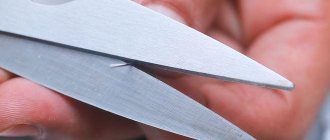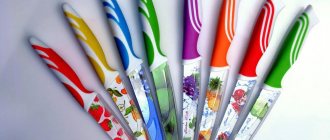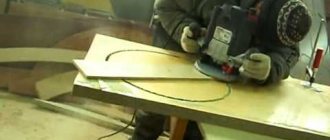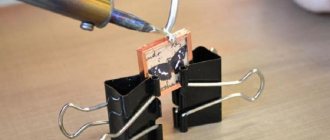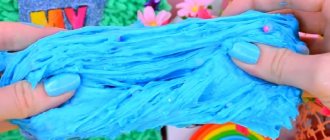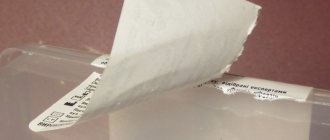Features of gluing edges to tabletops
An edge is the edge of furniture in the form of a strip that can protect it from adverse effects. If you do not glue the edge to the tabletop, it will not only cause an unaesthetic appearance, but also a negative impact on the human body through the release of toxic substances.
Accordingly, this device is mandatory and it is absolutely impossible to do without it. This especially applies to the table that is located in the kitchen, because it is constantly exposed to moisture and it is a matter of time before it loses its appearance.
Gluing the edge to the tabletop at home to the edges is not difficult, but you will need to treat each step as carefully as possible in order to avoid possible mistakes.
Where should edging be done?
As mentioned earlier, edging is necessary not only to make the product look beautiful. In addition, it helps protect furniture from moisture and households from exposure to chemical elements. Based on this, we can conclude that edging is necessary:
- in the kitchen - during family meals, household members should not inhale fumes of resins that are in the chipboard material, as well as in the kitchen space there is high humidity and water is often used, therefore, in order to avoid premature failure of furniture, swelling of surfaces from moisture and other unpleasant consequences from interaction with moisture, be sure to trim the ends with an edge.
- in living spaces - a table made of chipboard can be in a children's room, and children will study lessons behind it, or it can be in a study or office - it doesn't matter, in all these cases safety and protection from formaldehyde is important, which edging can provide.
Types of furniture edges
Countertops come in different varieties and each can be used in a specific environment. For example, the bathroom will need more moisture resistance than other rooms.
In the kitchen or office, you need a suitable design so that the entire countertop blends correctly with the interior. To correctly decide which material to choose an edge from, below are its main types.
Types of profiles
The edges of furniture are not only processed with edgebanding. One of the decorative and protective methods of finishing cuts is profiles - special linings that are put on the cut or inserted into pre-cut grooves in the chipboard. Profiles change the look of the furniture, serve as an additional decorative element, and effectively protect the inside of the chipboard from the effects of the external environment.
T-shaped
To process the edges with a T-shaped profile, a groove is pre-cut in the slab using a milling cutter. At the final stage of furniture assembly, the profile is inserted into the prepared hole (hammered with a soft hammer). T-shaped profiles are made with a girth or with simple overlays on the edge. Typically aluminum or PVC is used.
U-shaped
C- or U-shaped profiles do not require cutting a groove in the slab; they are simply put on the edge and secured with glue. It is important to choose a good adhesive and attach the trim tightly to avoid voids. U-shaped pads are produced from soft and hard materials. Rigid parts are stronger, but installation on rounded edges is more difficult. The profile will have to be heated to give it flexibility and secured with tape until the glue dries.
Important: the edges on the profile hide poor-quality edge cuts and small chips on the surface of the facades. The profile not only protects the chipboard, but also decorates the furniture.
How to glue an edge to a tabletop with your own hands
There are certain nuances when gluing edges to a tabletop. You should check the surface of the furniture for possible relief. Because after gluing, it may turn out that the edge does not hold well or the whole look does not look aesthetically pleasing.
If no irregularities are found or they have been eliminated in advance, then you can begin to work. To do this, below are the step-by-step steps:
- Prepare the tools that may be needed when edging, namely: a knife for cutting material; a cloth previously soaked in water; solvent, acetone for surface treatment; a hair dryer for bonding, preferably a hair dryer, or you can use an iron.
- Next, position the tabletop so that you can work with it comfortably. Prepare a purchased edge, which can be selected according to the recommendations presented above.
- To increase adhesion, all contamination should be removed from the end surface of the tabletop. You can use water, but the most reliable option is to use a solvent. But before using it, you should find out whether it is suitable for this type of work and whether it will enter into a chemical reaction with the countertop or the selected edge.
- You need to measure how much edge length is required to cover the side surface of the tabletop.
- After which some time must pass until the edge tape and the side surface of the tabletop dry.
- The next step is to begin gluing by applying the adhesive side of the edge to the tabletop. At the same time, you need to heat the surfaces with a hairdryer or iron.
- After adhesion of the surfaces to the adhesive, use scissors and trim the edges. Finally, additional processing can be done using sandpaper.
Material and tools for work
To do the edging of the tabletop yourself, you need to prepare all the necessary tools:
- an ordinary household iron or a hair dryer for heating the edge;
- construction knife (it is important to stock up on new blades);
- fine-grained sandpaper;
- scissors.
The materials you need to prepare are:
- tabletop on which the edge will be glued;
- the edge itself, matching the color and thickness.
Which glue to choose for edges
In most cases, the edge is supplied with an adhesive applied to it. But if this is not the case, then you need to purchase universal glue or PVC.
As a rule, the first option is not recommended for every type of work, since the glue can have a specific effect on the material, but at the same time this also applies to PVC. The second is that it does not always withstand moisture and can begin to deteriorate under its influence.
But before buying universal glue, you need to ask the seller whether it has a negative effect on the material of the table top and edges. A good choice for purchase would be Lux glue. This glue can be used to easily attach the edge to the tabletop.
Melamine tape
The cheapest and most accessible way to improve edges. Does not require the purchase of glue or specialized tools. Everything you need can be found in any household, and the process will take a few minutes.
The edge processed in this way looks very neat.
Should be used for finishing hard-to-reach edges of table tops. At the same time, do not forget about dampness, which will penetrate under the edge and destroy the material.
The gluing technology looks quite simple.
- Turn on and heat up the iron. Select the temperature so that the paper base of the material and glue do not burn.
- Cut the tape 2 cm longer than the edge to be processed.
- Attach the melamine strip to the end of the tabletop with the side on which the adhesive is applied.
Therefore, at this stage it is important to align it along one edge, as in the photo.
The iron should not burn the edge, but should well melt the glue that is applied to its reverse side.
Do not use a sharp knife, it will cut off the edges of the material and ruin the whole look.
How to glue an edge without adhesive
If there is no adhesive applied to the edge, then it must be purchased separately. In this case, you need to apply glue to both surfaces to get the best adhesion. If too much of the compound has been applied, it needs to be removed because it has not hardened.
Gluing the edge to the tabletop is a job that should not be neglected. Otherwise, the furniture can easily deteriorate under the influence of moisture or cause harm to human health. Edge material is available in almost every store, which is why choosing a tape does not cause any inconvenience.
PVC strip
A more progressive and aesthetically pleasing way. True, its implementation requires some skill, but after practicing on scraps, you can master this method.
The edge, resistant to abrasion and moisture, will ensure long-term use of the tabletop in any interior.
When gluing the PVC edge, follow the following sequence.
- Cut a strip of finishing material 2 cm longer than the edge to be processed.
- Heat the edge with a hair dryer on the glue side or with an iron on the front side.
To glue the edges, use an industrial hair dryer with a heating temperature of 250 degrees.
If you are using a material without an adhesive base, use “88-Lux” glue or something similar.
Apply to the cut strip and wait for the time specified according to the instructions. In 2-3 minutes. Before the end of the period, cover the end of the tabletop with a thin layer of glue.
The blade of the knife should go along the plane of the part, thus evenly cutting off the protruding part of the edge.
The edge treated with fine-grit sandpaper will be even and smooth.
A properly selected and glued edge will give the tabletop an attractive appearance, and it will serve you for many years.
You can also get such a smooth and neat edge yourself.



